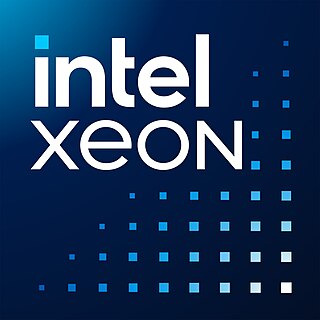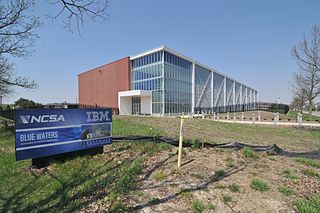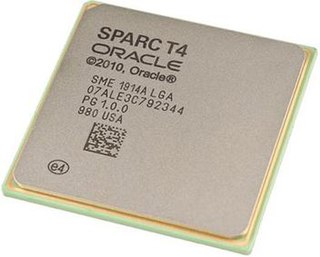
Xeon is a brand of x86 microprocessors designed, manufactured, and marketed by Intel, targeted at the non-consumer workstation, server, and embedded markets. It was introduced in June 1998. Xeon processors are based on the same architecture as regular desktop-grade CPUs, but have advanced features such as support for error correction code (ECC) memory, higher core counts, more PCI Express lanes, support for larger amounts of RAM, larger cache memory and extra provision for enterprise-grade reliability, availability and serviceability (RAS) features responsible for handling hardware exceptions through the Machine Check Architecture (MCA). They are often capable of safely continuing execution where a normal processor cannot due to these extra RAS features, depending on the type and severity of the machine-check exception (MCE). Some also support multi-socket systems with two, four, or eight sockets through use of the Ultra Path Interconnect (UPI) bus, which replaced the older QuickPath Interconnect (QPI) bus.

POWER7 is a family of superscalar multi-core microprocessors based on the Power ISA 2.06 instruction set architecture released in 2010 that succeeded the POWER6 and POWER6+. POWER7 was developed by IBM at several sites including IBM's Rochester, MN; Austin, TX; Essex Junction, VT; T. J. Watson Research Center, NY; Bromont, QC and IBM Deutschland Research & Development GmbH, Böblingen, Germany laboratories. IBM announced servers based on POWER7 on 8 February 2010.

A data center 64 bit microserver is a server class computer which is based on a system on a chip (SoC). The goal is to integrate all of the server motherboard functions onto a single microchip, except DRAM, boot FLASH and power circuits. Thus, the main chip contains more than only compute cores, caches, memory interfaces and PCI controllers. It typically also contains SATA, networking, serial port and boot FLASH interfaces on the same chip. This eliminates support chips at the board level. Multiple microservers can be put together in a small package to construct dense data center.
Cavium, Inc. was a fabless semiconductor company based in San Jose, California, specializing in ARM-based and MIPS-based network, video and security processors and SoCs. The company was co-founded in 2000 by Syed B. Ali and M. Raghib Hussain, who were introduced to each other by a Silicon Valley entrepreneur. Cavium offers processor- and board-level products targeting routers, switches, appliances, storage and servers.
Tilera Corporation was a fabless semiconductor company focusing on manycore embedded processor design. The company shipped multiple processors in the TILE64, TILEPro64, and TILE-Gx lines.

Blue Waters was a petascale supercomputer operated by the National Center for Supercomputing Applications (NCSA) at the University of Illinois at Urbana-Champaign. On August 8, 2007, the National Science Board approved a resolution which authorized the National Science Foundation to fund "the acquisition and deployment of the world's most powerful leadership-class supercomputer." The NSF awarded $208 million for the Blue Waters project.

The ARM Cortex-A9 MPCore is a 32-bit multi-core processor that provides up to 4 cache-coherent cores, each implementing the ARM v7 architecture instruction set. It was introduced in 2007.
SiCortex was a supercomputer manufacturer founded in 2003 and headquartered in Clock Tower Place, Maynard, Massachusetts. On 27 May 2009, HPCwire reported that the company had shut down its operations, laid off most of its staff, and is seeking a buyer for its assets. The Register reported that Gerbsman Partners was hired to sell SiCortex's intellectual properties. While SiCortex had some sales, selling at least 75 prototype supercomputers to several large customers, the company had never produced an operating profit and ran out of venture capital. New funding could not be found.

The SPARC64 V (Zeus) is a SPARC V9 microprocessor designed by Fujitsu. The SPARC64 V was the basis for a series of successive processors designed for servers, and later, supercomputers.
Manycore processors are special kinds of multi-core processors designed for a high degree of parallel processing, containing numerous simpler, independent processor cores. Manycore processors are used extensively in embedded computers and high-performance computing.
Schooner Information Technology, Inc. provided database management system appliances for Web 2.0, cloud computing and data centers. It was headquartered in Sunnyvale, California, and acquired by SanDisk in 2012.

The ARM Cortex-A15 MPCore is a 32-bit processor core licensed by ARM Holdings implementing the ARMv7-A architecture. It is a multicore processor with out-of-order superscalar pipeline running at up to 2.5 GHz.

The SPARC T4 is a SPARC multicore microprocessor introduced in 2011 by Oracle Corporation. The processor is designed to offer high multithreaded performance, as well as high single threaded performance from the same chip. The chip is the 4th generation processor in the T-Series family. Sun Microsystems brought the first T-Series processor to market in 2005.
The SPARC T-series family of RISC processors and server computers, based on the SPARC V9 architecture, was originally developed by Sun Microsystems, and later by Oracle Corporation after its acquisition of Sun. Its distinguishing feature from earlier SPARC iterations is the introduction of chip multithreading (CMT) technology, a multithreading, multicore design intended to drive greater processor utilization at lower power consumption.

SPARC T5 is the fifth generation multicore microprocessor of Oracle's SPARC T series family. It was first presented at Hot Chips 24 in August 2012, and was officially introduced with the Oracle SPARC T5 servers in March 2013. The processor is designed to offer high multithreaded performance, as well as high single threaded performance from the same chip.

POWER9 is a family of superscalar, multithreading, multi-core microprocessors produced by IBM, based on the Power ISA. It was announced in August 2016. The POWER9-based processors are being manufactured using a 14 nm FinFET process, in 12- and 24-core versions, for scale out and scale up applications, and possibly other variations, since the POWER9 architecture is open for licensing and modification by the OpenPOWER Foundation members.
This is a comparison of ARM instruction set architecture application processor cores designed by ARM Holdings and 3rd parties. It does not include ARM Cortex-R, ARM Cortex-M, or legacy ARM cores.

Ampere Computing LLC is an American fabless semiconductor company based in Santa Clara, California that develops processors for servers operating in large scale environments. It was founded in 2017 by Renée James.
The A64FX is a 64-bit ARM architecture microprocessor designed by Fujitsu. The processor is replacing the SPARC64 V as Fujitsu's processor for supercomputer applications. It powers the Fugaku supercomputer, ranked in the TOP500 as the fastest supercomputer in the world from June 2020, until falling to second place behind Frontier in June 2022.
The ARM Neoverse is a group of 64-bit ARM processor cores licensed by Arm Holdings. The cores are intended for datacenter, edge computing, and high-performance computing use. The group consists of ARM Neoverse V-Series, ARM Neoverse N-Series, and ARM Neoverse E-Series.










